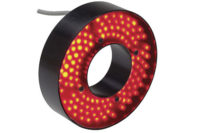In previous blogs, we have discussed increasing photodetected signal/noise ratio by using lighting techniques appropriate to the product. When signal/noise ratios are not high enough, these auto-compensating techniques may be of help.
One basic design uses the output difference of two detector signals. The two photosensors detect light from two different but equivalent areas on the product. The areas are illuminated by a single light source. The outputs of the two photosensors are subtracted using an integrated circuit(IC) difference amplifier.
For example, to detect defects along a coated wire, separate the two sensors so that they collect reflected/scattered light from two different areas along the wire.
If it is required to inspect opposite sides of the wire, the illumination from the single light source can be easily positioned by using a bifurcated (Y-shaped), randomized, fiber optic cable. The single light source illuminates the single thicker arm and is divided into the two thinner arms. The output light from the two thin arms of the fiber optic cable is aimed at the two different areas.
Optical Defect Detection
This design compensates for several undesirable features of inexpensive equipment for defect detection:1. Fluctuations in photodetected light intensities from single-source / single-detector are subtracted out.
For example, we have measured 60-cycle variations in signal intensity of 10% to 15% from a single AC-powered incandescent bulb due to the 60 cycle heating and cooling of the filament. The AC-modulation depth depends on filament characteristics such as thickness and geometry. (More expensive high-frequency and/or intensity-stabilized light sources are alternative solutions.)
2. Slow variations in color or texture in subject samples are subtracted out.
3. Changes in the amplifiers due to thermal shifts are subtracted out.
Defect detection of fast signal pulses (i.e. faster than detector/amplifier response time) due to high speed production lines and/or small defects can be dealt with by using commercially available IC pulse stretchers to broaden the pulses.
Dynamic Positioning
Auto-compensated (or balanced) photodetectors can also be used for dynamic positioning. In addition to dynamically compensating for changes in light source and detector performance, this can be used to double the sensitivity of the position determination.In one example, positioning of a friction-welding head was necessary for welding of small curved structural elements on airplane wings.
Here, a fixture consisting of an illuminated guiding thin, matte white plastic cylinder was mounted, on a dark background, parallel to the required curved paths along the wings. The opposing edges of the illuminated plastic cylinder were imaged onto two balanced photodetectors.
When the images were symmetrical, the difference signal produced was zero. When the positioning was off, then the difference signal became non-zero: the light intensity from one edge increased and the light intensity from the other edge decreased. In addition to the autocompensation features, this set-up gave twice the signal from improper positioning that a single detector would have provided.
We have also done dynamic balanced positioning with a machine vision system using a video camera and two regions of interest (also called areas of interest) that collect the light from the opposite edges of the illuminated cylinder. Here, the total intensities from each of the two regions of interest are computed and the two total intensities are subtracted.
Summary
Auto-compensated or balanced photosensing is a practical way to reduce and eliminate interfering variations and fluctuations in light source intensities and sample characteristics.This can improve signal/noise ratio and increase detection and measurement sensitivity.
Note: Balanced amplifier photodetectors can be made from inexpensive components Commercially available high performance units are used in optical coherence tomography (OCT), heterodyne detection, spectroscopy, laser fluctuations and other areas.
